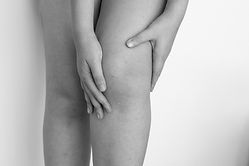
Lower Limb
Conditions

ANKLE SPRAIN
Ankle sprains rank among the most common injuries Australians face. When an ankle twists, its ligaments can become overstretched, and in severe cases, torn. This overstretching also damages small blood vessels, leading to swelling around the ankle.
Mild sprain (grade I): This form of sprain, the most common and least severe, involves stretched but not torn ligaments.
Moderate sprain (grade II): More severe and painful, this injury results in partial tearing of one or more ligaments.
Severe sprain (grade III): In this grade, one or more ligaments are completely torn, leaving the ankle unstable and greatly restricting foot movement.
Signs and Symptoms of Ankle Sprain:
-
Pain and tenderness around the ankle
-
Swelling and bruising over the ankle
-
Inability to walk or stand on the joint
-
Ankle stiffness
Treatment Method:
-
Cryotherapy
-
Ultrasound Therapy
-
Pulsed electromagnetic field (PEMF)
-
Acupuncture
-
Manipulative Therapy
-
Exercise Therapy
-
Thermotherapy
Don't let an ankle sprain slow you down. Contact us today to schedule an appointment and start your journey toward recovery.

FLAT FEET
Flat feet is a condition prevalent among Australians, where the foot arch collapses and makes complete or near-complete contact with the ground. This reduces the foot arch's ability to absorb shock, leading to increased stress on the heel, ankle, knee, and lower back.
Signs and Symptoms of Flat Feet:
-
Collapsed foot arch
-
Excessive pronation of the heel
-
Midfoot pain
-
Possible association with hip, knee, and lower back pain
If flat feet are impacting your mobility and causing discomfort, don't hesitate to reach out. Contact us today to explore treatment options and regain comfort and stability in your feet.

Knee
osteoarthritis
Also referred to as OA knee, osteoarthritis is a condition that causes joints to become painful and stiff. The severity of osteoarthritis symptoms can vary greatly from person to person. For some people, the symptoms can be mild and may come and go. Other people can experience more continuous and severe problems.
Signs and Symptoms of OA Knee:
-
Knee pain worsens after activities like walking up stairs
-
Swelling around the knee joint
-
Stiffness in the knee when bending or straightening
-
Clicking sounds in the knee joint
-
Knee buckling or locking up
If you're experiencing knee discomfort or knee pain due to osteoarthritis, it's essential to seek treatment to manage pain and improve mobility. Contact us today to schedule an appointment and take the first step towards managing your OA knee effectively.

PLANTAR FASCIITIS
Plantar fasciitis, a prevalent cause of heel pain, often results from factors like improper footwear, weight gain, or high-impact activities such as running. Individuals with flat feet or weak foot arch control muscles are particularly susceptible to this condition.
Signs and Symptoms of Plantar Fasciitis:
-
Heel pain accompanied by swelling
-
Intense pain during the first steps after waking or prolonged periods of inactivity
-
Pain may gradually subside with continued walking
Effective treatment for plantar fasciitis is crucial to alleviate discomfort and restore mobility. Reach out to our skilled physiotherapists now to find relief from heel pain and regain your active lifestyle.